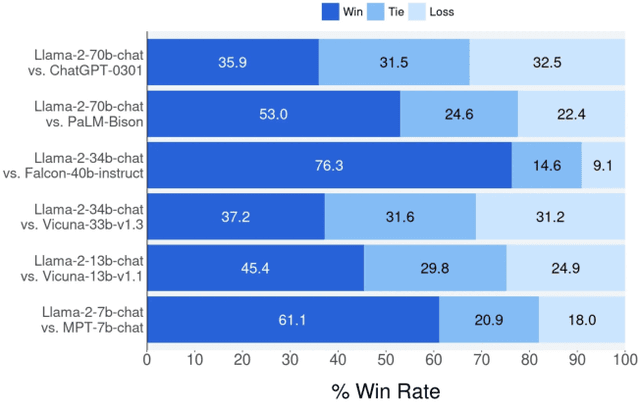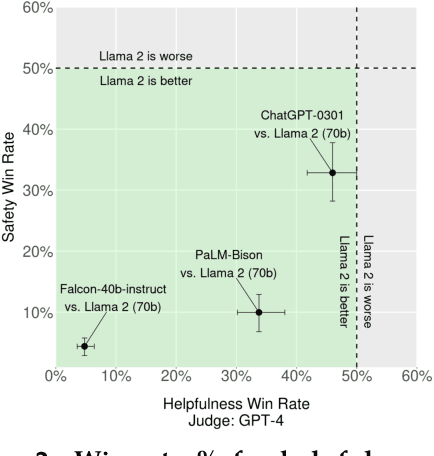Marcin Kardas
Jack
The Llama 3 Herd of Models
Jul 31, 2024Abstract:Modern artificial intelligence (AI) systems are powered by foundation models. This paper presents a new set of foundation models, called Llama 3. It is a herd of language models that natively support multilinguality, coding, reasoning, and tool usage. Our largest model is a dense Transformer with 405B parameters and a context window of up to 128K tokens. This paper presents an extensive empirical evaluation of Llama 3. We find that Llama 3 delivers comparable quality to leading language models such as GPT-4 on a plethora of tasks. We publicly release Llama 3, including pre-trained and post-trained versions of the 405B parameter language model and our Llama Guard 3 model for input and output safety. The paper also presents the results of experiments in which we integrate image, video, and speech capabilities into Llama 3 via a compositional approach. We observe this approach performs competitively with the state-of-the-art on image, video, and speech recognition tasks. The resulting models are not yet being broadly released as they are still under development.
Llama 2: Open Foundation and Fine-Tuned Chat Models
Jul 19, 2023



Abstract:In this work, we develop and release Llama 2, a collection of pretrained and fine-tuned large language models (LLMs) ranging in scale from 7 billion to 70 billion parameters. Our fine-tuned LLMs, called Llama 2-Chat, are optimized for dialogue use cases. Our models outperform open-source chat models on most benchmarks we tested, and based on our human evaluations for helpfulness and safety, may be a suitable substitute for closed-source models. We provide a detailed description of our approach to fine-tuning and safety improvements of Llama 2-Chat in order to enable the community to build on our work and contribute to the responsible development of LLMs.
Galactica: A Large Language Model for Science
Nov 16, 2022Abstract:Information overload is a major obstacle to scientific progress. The explosive growth in scientific literature and data has made it ever harder to discover useful insights in a large mass of information. Today scientific knowledge is accessed through search engines, but they are unable to organize scientific knowledge alone. In this paper we introduce Galactica: a large language model that can store, combine and reason about scientific knowledge. We train on a large scientific corpus of papers, reference material, knowledge bases and many other sources. We outperform existing models on a range of scientific tasks. On technical knowledge probes such as LaTeX equations, Galactica outperforms the latest GPT-3 by 68.2% versus 49.0%. Galactica also performs well on reasoning, outperforming Chinchilla on mathematical MMLU by 41.3% to 35.7%, and PaLM 540B on MATH with a score of 20.4% versus 8.8%. It also sets a new state-of-the-art on downstream tasks such as PubMedQA and MedMCQA dev of 77.6% and 52.9%. And despite not being trained on a general corpus, Galactica outperforms BLOOM and OPT-175B on BIG-bench. We believe these results demonstrate the potential for language models as a new interface for science. We open source the model for the benefit of the scientific community.
AxCell: Automatic Extraction of Results from Machine Learning Papers
Apr 29, 2020



Abstract:Tracking progress in machine learning has become increasingly difficult with the recent explosion in the number of papers. In this paper, we present AxCell, an automatic machine learning pipeline for extracting results from papers. AxCell uses several novel components, including a table segmentation subtask, to learn relevant structural knowledge that aids extraction. When compared with existing methods, our approach significantly improves the state of the art for results extraction. We also release a structured, annotated dataset for training models for results extraction, and a dataset for evaluating the performance of models on this task. Lastly, we show the viability of our approach enables it to be used for semi-automated results extraction in production, suggesting our improvements make this task practically viable for the first time. Code is available on GitHub.
MultiFiT: Efficient Multi-lingual Language Model Fine-tuning
Sep 10, 2019



Abstract:Pretrained language models are promising particularly for low-resource languages as they only require unlabelled data. However, training existing models requires huge amounts of compute, while pretrained cross-lingual models often underperform on low-resource languages. We propose Multi-lingual language model Fine-Tuning (MultiFiT) to enable practitioners to train and fine-tune language models efficiently in their own language. In addition, we propose a zero-shot method using an existing pretrained cross-lingual model. We evaluate our methods on two widely used cross-lingual classification datasets where they outperform models pretrained on orders of magnitude more data and compute. We release all models and code.
Universal Language Model Fine-Tuning with Subword Tokenization for Polish
Oct 24, 2018



Abstract:Universal Language Model for Fine-tuning [arXiv:1801.06146] (ULMFiT) is one of the first NLP methods for efficient inductive transfer learning. Unsupervised pretraining results in improvements on many NLP tasks for English. In this paper, we describe a new method that uses subword tokenization to adapt ULMFiT to languages with high inflection. Our approach results in a new state-of-the-art for the Polish language, taking first place in Task 3 of PolEval'18. After further training, our final model outperformed the second best model by 35%. We have open-sourced our pretrained models and code.
 Add to Chrome
Add to Chrome Add to Firefox
Add to Firefox Add to Edge
Add to Edge